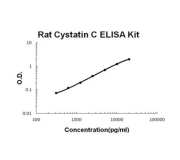Rat Cystatin C ELISA Kit (Part FPEK1109)
Rat Cystatin C ELISA Kit (96T)
Highly sensitive kit to rat Cystatin C. Validated for sensitive and selective detection in cell culture medium, serum and plasma.
Currently unavailable. Call for availability of related kit to same target.
Highlights
- Fully configured colorimetric ELISA kit in sandwich fomat.
- Natural - purified protien provided as standard.
- Assay range: 312pg/ml-20,000pg/ml.
- Validated for cell culture medium, serum and plasma.
Kit Contents
| Description | Quantity |
| 96- well plate precoated with anti-rat Cystatin C antibody | 1 |
| Lyophilized natural rat Cystatin C standard | 10ng (1 vial) |
| Biotinylated anti-rat Cystatin C Antibody | 130 ul (dilution 1:100) |
| Sample diluent buffer |
30 ml |
| Antibody diluents buffer |
12 ml |
| ABC diluents buffer |
12 ml |
| TMB color developing agent |
10 ml |
| TMB stop solution |
10 ml |
Cystatin C ELISA Kits Availability And Specifications
|
Species |
Assay Range |
| Human | 312pg/ml-20,000pg/ml |
| Rat | 312pg/ml-20,000pg/ml |
| Mouse | 312pg/ml-20,000pg/ml |
Use Available Options menu to select the species specificity of the Cystatin C ELISA Kits.
Background
Cystatin C is a protein encoded by the CST3 gene. It is mainly used as a biomarker of kidney disease but has more recently been associated with its relation to determining new-onset or deteriorating cardiovascular disease, as well as its relation to diseases involving amyloid such as Alzheimer's. It also acts as an inhibitor of cysteine proteases and lysosomal proteinases Cystatin C is found in all body fluids and tissues.
Methods Overview: Sandwich ELISA
This rat Cystatin C ELISA Kit is based on standard sandwich enzyme-linked immune-sorbent assay technology. A monoclonal antibody from mouse specific for Cystatin C has been precoated onto 96-well plates. Standards (from plasma) and test samples are added to the wells, a biotinylated detection polyclonal antibody from goat specific for Cystatin C is added subsequently and then followed by washes with PBS or TBS buffer. Avidin-Biotin-Peroxidase Complex is added and unbound conjugates were washed away with PBS or TBS buffer. The HRP substrate TMB is used to visualize HRP enzymatic reaction. TMB is catalyzed by HRP to produce a blue color product that changes into yellow after adding acidic stop solution. The density of yellow is proportional to rat cycstatin C captured on the plate.
|
Representative Sandwich ELISA Methods |
- Add sample to plate, incubate 90 min, 37oC.
- Add detection antibody, incubate 1 hr, 37oC.
- Add ABC solution, incubate 30 min 37oC.
- Add chromogens, incubate in dark for 25 min.
- Add stop solution. Measure OD at 450nm.
References
1. Grubb, A.; Lofberg, H. : Human gamma-trace, a basic microprotein: amino acid sequence and presence in the adenohypophysis. Proc. Nat. Acad. Sci. 79: 3024-3027, 1982.
2. Pirttila, T. J.; Manninen, A.; Jutila, L.; Nissinen, J.; Kalviainen, R.; Vapalahti, M.; Immonen, A.; Paljarvi, L.; Karkola, K.; Alafuzoff, I.; Mervaala, E.; Pitkanen, A. : Cystatin C expression is associated with granule cell dispersion in epilepsy. Ann. Neurol. 58: 211-223, 2005.
3. Abrahamson, M. : Human cysteine proteinase inhibitors: isolation, physiological importance, inhibitory mechanism, gene structure and relation to hereditary cerebral hemorrhage. Scand. J. Clin. Lab. Invest. 48 (suppl. 191): 21-31, 1988.
4. Pirttila, T. J.; Manninen, A.; Jutila, L.; Nissinen, J.; Kalviainen, R.; Vapalahti, M.; Immonen, A.; Paljarvi, L.; Karkola, K.; Alafuzoff, I.; Mervaala, E.; Pitkanen, A. : Cystatin C expression is associated with granule cell dispersion in epilepsy. Ann. Neurol. 58: 211-223, 2005.
Safety: Stop solution contains acid. Avoid eye contact. Wear eye protection and gloves.
Storage: Store at 4°C for 6 months, at -20°C for 12 months. Avoid multiple freeze-thaw cycles.
Shipping. Overnight delivery
 Products
Products Manuals
Manuals
